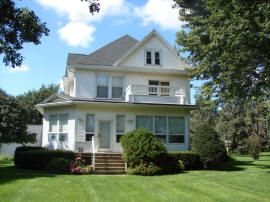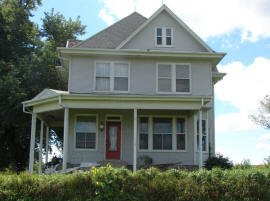|
 Reynolds
topic was close to home, well in
fact, her topic was her home, a
two-storey house on Route 121 south
of Lincoln that has a storied
history. The house is one of as many
as 100,000 homes sold from the
Sears, Roebuck and Company catalog
during the early years of the 20th
century. Reynolds
topic was close to home, well in
fact, her topic was her home, a
two-storey house on Route 121 south
of Lincoln that has a storied
history. The house is one of as many
as 100,000 homes sold from the
Sears, Roebuck and Company catalog
during the early years of the 20th
century.
For about the last century, at least
until the later part of the 20th
century, the department store chain
mail order catalog was the main way
to buy almost anything. The Sears
catalog would be delivered right to
a customer’s doorstep by the Postal
Service and all a person had to do
was mail in an order form and have
the item delivered right to the
home.
The big players in catalogue sales
were JC Penny, Montgomery Ward, and
the world famous Sears, Roebuck &
Company. In 1894, the Sears catalog
had 322 pages, covering almost any
product a household could use.
Since the digital age took over,
Amazon and eBay have mostly
supplanted the old line retailers.

“You could buy anything from the
Sears catalog,” said Sharon
Reynolds. And one of the most
unusual choices, was all of the
necessary items to build a complete
house. “Sears sold houses from their
catalog between 1908 and 1940. Our
house was purchased by Ruben Miller
around 1916, and with the help of
his brother, constructed at its
present location,” she said.
“There were no specialty contractors
on the job. When people ordered a
Sears home, they expected to build
it themselves with help from family
and friends,” she added.
The Reynolds house was model number
132, which was later given a name,
the Palmyra.
|

The Reynolds’ beautifully
restored Sears home.
|
Sharon said “Our number 132 was
the second of this model built near
Lincoln. The first one is still
standing about six miles west of
Lincoln on Fifth Street Road,”
Reynolds said.
|

The very first Sears home
model 132 is west of
Lincoln. Note the same roof
line as the Reynolds’
home.
|
Once a Sears house was ordered,
it was shipped by railroad, all
30,000 parts of it amounting to 25
tons, to a location near the
customer, who then picked it up at
the station. In the case of the
Reynolds’ house, the railroad had a
station at the present location of
the Chestervale elevator, so it was
a relatively easy task to move all
of the parts to the nearby building
site.

The Sears homes were considered
state-of-the-art at the time. When
all of the myriad parts were put
together, the house had built in
plumbing in an era of outside
facilities, especially in country
homes. It had two indoor bathrooms,
one on each floor of the two story
house. The houses had wiring for
electricity and a Delco generator to
provide that electricity, although
some early models had built in
piping for gas illumination. The
house had central heating that could
be paired with a coal fired boiler
that provided hot water heat, when
many houses were still heated by
fireplaces and wood burning stoves.
The houses even had built in
cabinets.
The houses came with roofing
options. The Reynolds’ house has
slate roof, but shingles and metal
roofing were also offered.
[to
top of second column]
|

“The Sears house was a distinctly
American concept, and set the tone
for marketing and mass produced
products that took hold in the 20th
century,” said Sharon. Sears even
owned a lumber mill in southern
Illinois that mass produced the
wooden parts of the homes.
Depending on the model selected, the
price of the houses was anywhere
from $360 to $2,890, when they were
initially offered. Sears even
provided financing, although this
practice was eliminated in the 1934
due to the large number of defaults
during the Great Depression.
When the Reynolds family
purchased their house, it had sat
empty for five years. When they
brought in a contractor to inspect
the house and recommend a course for
restoration, he noticed that the
roof rafters had numbers stamped on
them. “This was our first indication
that we had a Sears’ house,”
Reynolds said.
The blueprints for construction of a
Sears’ house referred to stamped
numbers on the thousands of parts to
get the correct order of
construction. The numbering system
on the parts is one clue that a
house may be a Sears’ catalog house.
Unfortunately, all of the sales
records for Sears’ homes were
destroyed during the 1940’s during
an ill conceived paperwork house
cleaning by the corporation. A ten
step investigation developed by a
house historian is one way to
positively identify an authentic
Sears’ home. No one knows where the
next Sears’ house will be
discovered.
Sears used architects to design its
catalog homes. The Reynolds’ house
has been standing for almost 100
years, which attests to the sturdy
quality of the building materials
and well designed house.
“Our Sears’ home has been a magnet
for visitors who own Sears’ homes of
their own. We have even had visits
from relatives of some of the
previous owners of this house. It
served three generations of the
original owner’s family,” Sharon
Reynolds said.

While individual Sears’ homes are
seen all over the country from
Florida to California, and even
Canada, there are clusters of the
houses in some locations. In
Illinois, Elgin and Carlinville have
large neighborhoods of Sears’ homes.
This usually was the result of a
large company providing housing for
workers at a nearby factory, or in
the case of Carlinville, a coal
mine.
Sharon and her husband Clyde have
showered their historic home with
attention to detail with the
intention of preserving this
important part of American history.
With a laugh, Sharon said “When we
bought the house, there was so much
work that needed to be done, we
thought it would be a five year
project. When five years came and
went, we moved the time line to ten
years to get it completed. When ten
years passed, we thought surely
fifteen years would see the project
completed. We have finally decided
that taking care of this special
house is a lifetime project.”
The beautiful house south of Lincoln
attests to the Reynolds’ love for
their home. Oh, and what about the
large cow head sticking out of the
end of their barn that faces Route
121? Well, that’s a completely
different story.
The Logan County Genealogical &
Historical Society meets the third
Monday of the month at 6:30 p.m. at
their research facility at 114 North
Chicago Street in Lincoln. After a
short business meeting, there is
always an interesting speaker
discussing fascinating subjects. The
phone number is 217-732-3200 and
email is
LCGHS1@hotmail.com Their
website is
www.logancoil-genhist.org The
Society also provides research for
those interested in their Lincoln
and Logan County heritage.
[By CURT FOX]
|